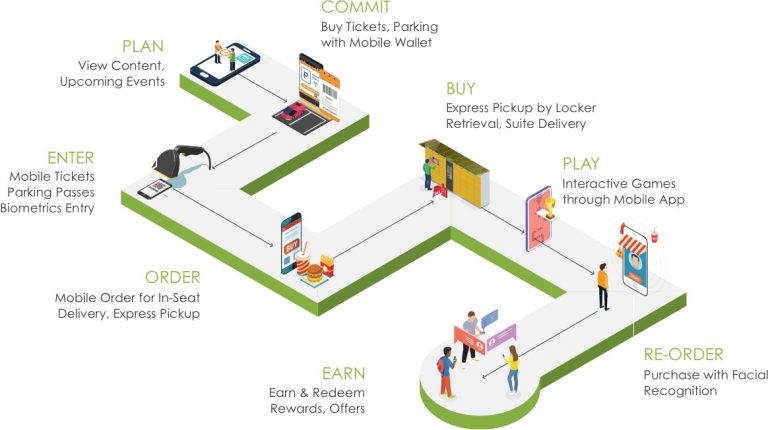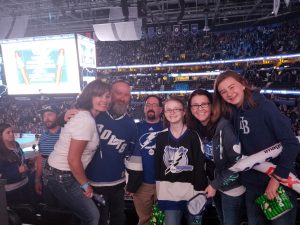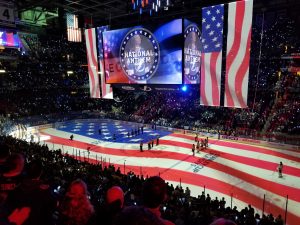
For many years, Venuetize has provided solutions that maintain ease and convenience for fans attending live events at a venue. In a post-COVID world, fans are going to demand a completely reinvented venue experience that reduces, if not eliminates, physical contact. That’s where the Touchless Fan Journey comes into play...
Dan is a huge fan and season ticket member (“STM”) of the Tampa Bay Lightning. He loads his Chase-issued VISA card to the mobile wallet in the AMALIE Arena app and automatically receives a digital $25 Arena Cash card to spend anywhere in his team’s home venue. Before a game, he can buy game tickets and pay for parking with the app’s mobile wallet. Once he arrives at the arena, he can buy concessions with a single scan of his mobile wallet at a point of sale terminal, which will also apply his 35% STM food and beverage discount. He can order a team jersey through the app, which will automatically apply his 25% STM merchandise discount and pick it up at his convenience from a locker in the concourse without having to wait in a long line at the team store. Even if he forgets his mobile phone at home, he can still buy things at the arena with “Pay with Face”, which leverages facial recognition censors at the concession stands.
In a series of seamless, convenient, and contactless transactions — without ever exchanging cash, presenting a card, or making physical contact with another person — Dan has interacted with a ticketing system, parking system, two point of sale systems, a membership system, the team, a concessionaire, a retail merchant, and a parking vendor, both in and out of the arena.
Our integrated eCommerce platform breaks down the silos between devices, interfaces, back-end operating systems, and merchants to create an easy, personalized, and seamless payments experience for both consumers and operators.
Let’s walk through the Touchless Fan Journey and look at each stage of a visitor’s experience and how venues must adapt and evolve their operations in order for fans to return.
- PLAN
Current Fan Experience: Fans browse websites, social sites, or use team and venue mobile apps to see upcoming events and search for tickets.
Opportunity: Digital communication channels offer a direct path to fans that allow fans to stay current on team-produced content, plan for their visit, and decide on transportation to the venue. Meanwhile, teams and venues can keep fans informed of COVID-related changes being made to venue operations, shifting event schedules, and updates on steps being taken to address health and safety concerns. - COMMIT
Current Fan Experience: Fans either purchase tickets through ticket sites, in the secondary market, or pay with cash at the box office.
Opportunity: Push fans to purchase tickets and pre-pay for parking using the mobile wallet in the team or venue app. Eliminate cash payments and physical credit/debit card transactions for tickets and parking by requiring mobile or web payments in advance of an event. - ENTER
Current Fan Experience: Most venues employ gate attendants who use handheld scanners to scan physical tickets or mobile barcodes for access control. For fans who have not purchased their tickets or parking passes in advance, they interact with a gate attendant to pay with cash or physical credit/debit cards.
Opportunity: Reduce fan-facing gate attendants and expedite entry by eliminating handheld scanners and installing freestanding turnstiles and biometrics sensors for facial recognition-based access control. - ORDER (F&B)
Current Fan Experience: Most fans walk up to a concessions stand and interact with concessions staff to place an order, often paying with cash or a physical credit/debit card. Lines are long, transaction times are inefficient, and there are multiple physical touch points throughout the process.
Opportunity: Reduce fan-facing concessions staff by enabling self-service, touchless options for fans to order and pay. Push pre-paid mobile ordering of food and beverage items for express pickup, and increase counter space for pick-up only stations. Enable fans to favorite items and past orders. Prompt repeat orders, and enable one-swipe pay in-app to expedite transaction speeds and increase order frequency. - BUY (MERCH)
Current Fan Experience: Long lines in crowded team stores, involving physical exchange of merchandise items, and payments involving cash or a physical credit/debit card.
Opportunity: Reduce fan-facing merchandise staff by enabling self-service, touchless options for fans to order and pay. Go 100% cashless by deploying cash-to-card kiosks. Install scanners at POS terminals and kiosks for mobile wallet payments. Enable NFC terminals for tap to pay. Introduce biometrics scanners for facial recognition-based payments at POS and kiosks. Push pre-paid mobile ordering of merchandise for express pickup or locker retrieval. - PLAY
Current Fan Experience: Limited options for interactive games.
Opportunity: Offer interactive games through the mobile app to increase fan engagement. Incentive play through action-based rewards, offers, and promotions that can be redeemed through the mobile app while also grooming future behavior for sports betting. - RE-ORDER
We’re using re-order to show another way to pay for concessions.
Current Fan Experience: No matter how many times fans order concessions, subsequent visits are not any faster or more personalized.
Opportunity: Go 100% cashless by deploying cash-to-card kiosks. Install scanners at POS terminals and kiosks for mobile wallet payments. Enable NFC terminals for tap to pay. Introduce biometrics scanners for facial recognition-based payments at POS and kiosks. Fans’ STM discounts get applied and their default method of payment is charged automatically through the mobile wallet, without them ever having to use their phone. - EARN
Current Fan Experience: Some fans may participate in loyalty programs with restrictive point-based economies or confusing earn and redemption policies, resulting in limited results for teams and questionable value for fans.
Opportunity: User action-based rewards promote desired fan behavior while personalizing relevant offers and benefits. Behavioral data can then be used for targeted marketing and upselling.
Teams and venues must take action now to adapt to the post-COVID world that will be demanded by fans, or risk empty venues. If you’d like to discuss your venue-specific options, contact the Venuetize team here to set up a time to learn more about how you can prepare to welcome back your fans with a touchless experience.







